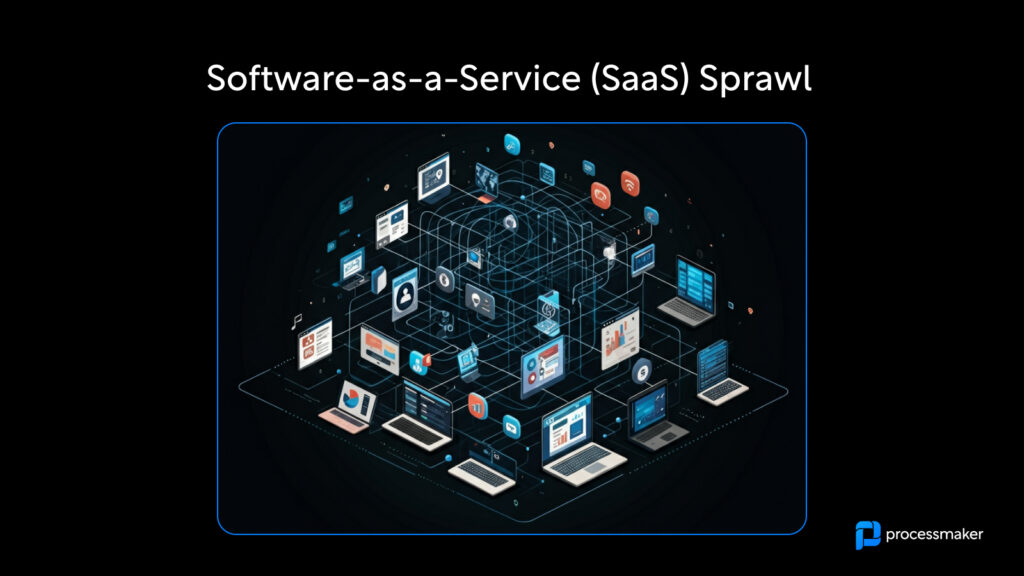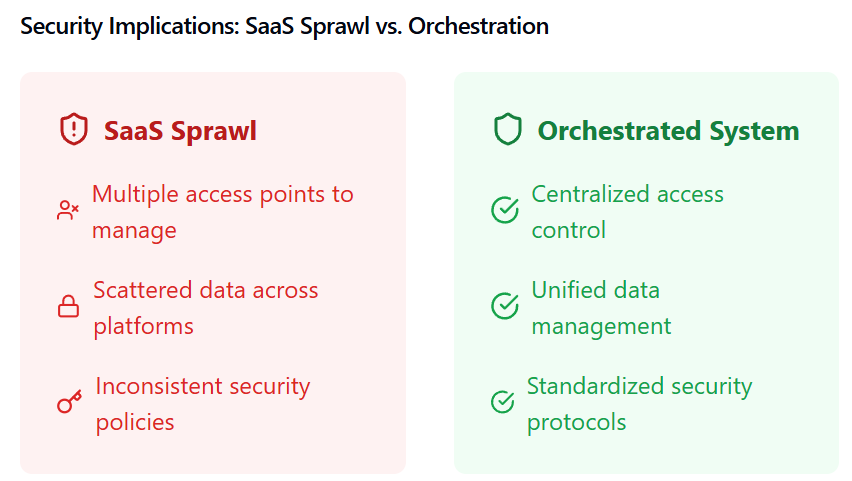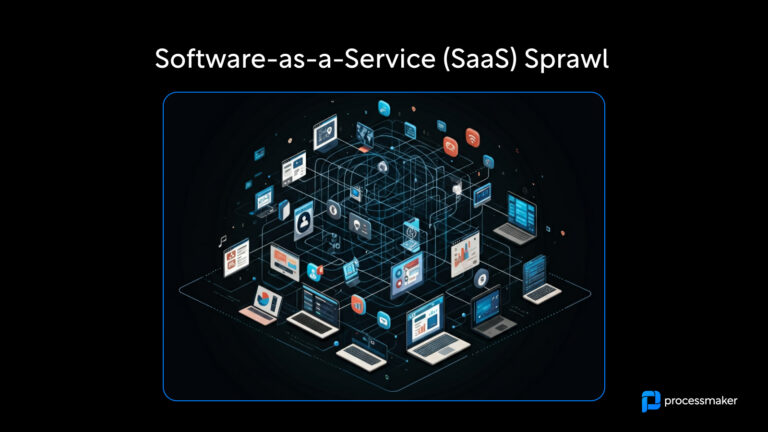To create and publish this one article you’re reading, we had to use at least five different SaaS solutions. And that’s just for an article. Recording a podcast or hosting an online webinar? Those tasks can require as many as 15 different software tools, all working together for just one episode or event.
And that’s only in marketing.
Now, don’t get us wrong—these SaaS tools are incredibly helpful. That’s why we rely on them. 😊 Each is excellent at its specific job, solving one particular problem we encounter. We use one platform to plan our week collaboratively, another to schedule everything, and yet another to integrate the first two. Before you know it, we’re juggling countless tools.
Well, not countless—it’s finite. On average, companies use around 150 tools, but in reality, that number often climbs into the 300s for larger organizations. This comes at a cost, with businesses spending between $1,000 and $3,500 annually per employee on SaaS applications.
The SaaS market reflects this incredible growth. According to Statista, its global value is projected to reach $317.55 billion by 2024, with over 30,000 unique solutions available today.
How did it all start?
The rise of cloud software made it much easier to develop point solutions for individual problems. Startups saw success by perfecting one specific niche, a strategy that allowed them to break into the market—and for a long time, this approach worked. But now, it has spiraled too far.
Companies began rapidly adopting these point solutions, giving way to a phenomenon known as SaaS sprawl. This happens when organizations lose oversight of the countless tools they’ve implemented, leading to skyrocketing costs, increased security risks, and operational inefficiencies.

Difficulties of having niche SaaS for everything
SaaS sprawl isn’t just a mild inconvenience—it’s a significant challenge that can hold businesses back from reaching their full potential.
- Increased costs
This one’s obvious, given the rising subscription fees. As departments independently adopt various SaaS tools, the total costs can become unmanageable. Unused licenses, overlapping features, and hidden “shadow IT” expenses inflate budgets unnecessarily. Take our marketing department as an example—we’re subscribed to about 37 SaaS tools, and I’m not entirely sure we’re using them all efficiently or even getting value for what we pay.
- Security risks
The more tools you add, the more places your data resides. A fragmented SaaS environment can create blind spots, making it harder to enforce security measures. Unauthorized tools or shadow IT can open doors to data breaches, placing sensitive information at risk.
- Operational (in)efficiencies
Ironically, instead of improving efficiency, the overuse of SaaS tools often creates more problems. While these apps were meant to streamline work, they’ve led to yet another layer of complexity.
Now, we need marketplace apps and integration tools just to manage the chaos—a whole new category of software designed to help us juggle all the others. Without a unified approach, communication gaps and redundant workflows bog down productivity.
- Complexity in management
Adding to the inefficiency, keeping track of countless tools, their updates, and user access is a logistical nightmare. Each tool comes with its unique interface, requiring time and training to master. Companies often need to hire dedicated operations teams just to handle this complexity—a solution that brings yet another increase in costs.
All in all, without a cohesive strategy, SaaS sprawl can quickly snowball into a costly and time-consuming burden.
AI is changing the landscape of SaaS sprawl
SaaS sprawl has pushed us to overconsume software tools, but the rapid advancement of AI may be paving the way for a new approach. With the power of advanced large language models (LLMs), Agentic AI changes the way companies manage tasks and processes, offering a smarter, more efficient alternative.
Imagine an Agentic AI as a point solution—not just another SaaS, but a more powerful and versatile one, thanks to its ability to adapt to a company’s unique needs.
This could potentially reduce the reliance on multiple overlapping tools, addressing not only the complexity of SaaS sprawl but also the underlying inefficiencies. Instead of juggling countless applications to accomplish simple goals, businesses could rely on the flexibility and intelligence of Agentic AI to simplify operations and cut costs.
However, even with AI coming to the rescue, there’s still a significant amount of complexity that needs centralized management.
How do you tackle a SaaS sprawl challenge?
There are several ways to tackle the problem of SaaS sprawl. One option is to hire a consulting company to develop a custom solution that consolidates all your tools or even build a unified system from the ground up. While this approach guarantees a solution tailored to your organization’s specific needs, it comes with significant drawbacks.
Developing such a solution takes considerable time and effort, often dragging on for months or even years. The costs are another major obstacle—custom solutions can require an enormous financial investment, making them impractical for most businesses. On top of that, in today’s fast-moving business environment, your needs may evolve by the time the complex solution is finally rolled out, leaving you with something outdated or misaligned with current priorities.
So, is there a faster, more efficient way to bring all your SaaS tools together while potentially reducing both their number and the associated costs? For large enterprises drowning in hundreds of applications spread across various functions and workflows, process orchestration offers a compelling answer.
Enter process orchestration
Process orchestration involves managing and automating intricate business processes that span multiple systems, applications, and teams. It integrates, automates, monitors, and scales processes under a unified framework, eliminating redundancies and enhancing overall efficiency. Platforms like ProcessMaker enable businesses to build their processes on a single platform by:
- Consolidating all SaaS applications into an integrated system.
- Allowing organizations to create and customize their own workflows with ease.
What sets process orchestration apart from traditional consulting solutions is its speed and simplicity. With a low-code platform like ProcessMaker, you can rapidly develop custom applications for specific processes without requiring extensive coding expertise and a team of consultants to help you. This not only accelerates implementation but also allows for immediate adjustments whenever business needs change. Instead of relying on multiple external tools, all essential functionalities are contained within one platform, enhancing effectiveness and saving costs.
Take control of your SaaS stack with ProcessMaker
Even with the abundance of specialized point solutions, the growing complexity of today’s business environment continues to fuel the demand for custom process orchestration.

This approach empowers organizations to tackle SaaS sprawl by providing a unified platform that does more than just manage the existing chaos of tools. It enables businesses to streamline operations and develop tailored solutions, significantly reducing the need to constantly purchase new software.
Process orchestration offers a smarter path forward—one that lets you take control of your software stack, optimize workflows, and eliminate redundancies. Reimagine how you use technology, and free your organization from the hassle of managing hundreds of SaaS applications.





